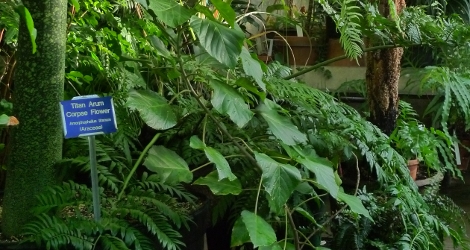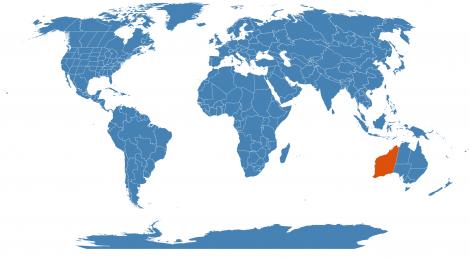Accession Data:
Acacia saligna (Labill.) H.L. Wendl.
- Common Name: Golden Wreath Wattle, Orange Wattle
- Family: Fabaceae Juss.
- Description: [syn. Acacia cyanophylla]
Large shrub or small tree to 10 m, sometimes developing a spreading crown. Phyllodes to 20 cm long and up to 2 cm wide, occasionally bluish. Flowers are large golden balls in spring.
Orange wattle is an extremely rugged tree, adaptable to barren slopes, derelict land, and exceptionally arid conditions in Australia and North Africa. It grows rapidly and is used for reclaiming eroded hillsides and wastelands and for stabilizing drift sands as well as for fuel. This is one of the best woody species for binding moving sand. It is useful for windbreaks, amenity plantings, beautification projects, and roadside stabilization in semiarid regions. The leaves, or phyllodes, are palatable to livestock when fresh or dried into hay, especially used as supplementary feed for sheep and goats. Crushed seeds have been fed to sheep without ill effects. Regrowth of established bushes is so good that Acacia saligna can be completely grazed off without harming the plants. The damaged bark exudes copious amounts of a very acidic gum that seems to show promise for use in pickles and other acidic foodstuffs
Acacia saligna is native to the southwestern corner of western Australia. In its native habitat, the summer temperature ranges from about 23°–36°C, winter temperatures from 4°–9°C. The plant does not withstand frost and grows best where the winter and summer means are between 13° and 30°C respectively. Grows from near sea level to about 300 m, with isolated occurrences at higher elevations. Particularly drought hardy, it grows where annual rainfall is as low as 250 mm, though it probably does better with 350–600 mm. It grows well where annual rainfall is as high as 1,000 mm. Grows mainly on sandy, coastal plains, but is found from swampy sites and riverbanks to small, rocky hills (often granitic) and coastal slopes. It occurs on poor acid or calcareous sands, under the most dry and adverse soil conditions, in moderately heavy clays and a range of podzols.
Edible Usage: Flowers - cooked. Rich in pollen, they are often used in fritters.
Other Usage: A yellow dye is obtained from the flowers. A green dye is obtained from the seed pods. On a 10% moisture basis, the bark contains 21.5% tannin. Plants are heavily armed with thorns and make a good screen or hedge in warm temperate areas.
Cultivation: Prefers a sandy loam and a very sunny position. Succeeds in dry soils. Succeeds in any good garden soil that is not excessively limey. Most species become chlorotic on limey soils. Tolerates maritime exposure. Trees are not very hardy outdoors in Britain, they tolerate occasional temperatures down to between -5 and -10øc, but even in the mildest areas of the country they are likely to be killed in excessively harsh winters. Plants spread by means of suckers and trees that have been killed in cold weather can sometimes regrow from the roots. This species has a symbiotic relationship with certain soil bacteria, these bacteria form nodules on the roots and fix atmospheric nitrogen. Some of this nitrogen is utilized by the growing plant but some can also be used by other plants growing nearby. It also has a symbiotic relationship with ants.
Seed - best sown as soon as it is ripe in a sunny position in a warm greenhouse. Stored seed should be scarified, pre-soaked for 12 hours in warm water and then sown in a warm greenhouse in March. Germinates in 3 - 4 weeks at 25øc. Cuttings of half-ripe wood with a heel, July/August in individual pots in a frame. Overwinter in a greenhouse for the first winter and plant out in their permanent positions in late spring or early summer.
- USDA Zone: 9-11
Accession Data:
- Accession # 199800164
- Source: Thompson & Morgan
- Accession Date: 10-21-1998
- Bench: 2107 - MED:Western Australia B
- Currently: active - healthy
- Qty: 1 confirmed on 03-24-2025
Classification:
- Division: Magnoliophyta
- Class: Magnoliopsida
- SubClass: eurosid I
- Order: Fabales
- SubOrder:
- Family: Fabaceae
- SubFamily: Mimosoideae
- Tribe: Acacieae
- SubTribe:
Flowering Data:
This accession has been observed in bloom on:| Year | Jan | Feb | Mar | Apr | May | Jun | Jul | Aug | Sep | Oct | Nov | Dec | ||||||||||||||||||||||||||||||||||||||||
|---|---|---|---|---|---|---|---|---|---|---|---|---|---|---|---|---|---|---|---|---|---|---|---|---|---|---|---|---|---|---|---|---|---|---|---|---|---|---|---|---|---|---|---|---|---|---|---|---|---|---|---|---|
| 2025 | ||||||||||||||||||||||||||||||||||||||||||||||||||||
| 2024 | ||||||||||||||||||||||||||||||||||||||||||||||||||||
| 2023 | ||||||||||||||||||||||||||||||||||||||||||||||||||||
| 2022 | ||||||||||||||||||||||||||||||||||||||||||||||||||||
| 2021 | ||||||||||||||||||||||||||||||||||||||||||||||||||||
| 2020 | ||||||||||||||||||||||||||||||||||||||||||||||||||||
| 2019 | ||||||||||||||||||||||||||||||||||||||||||||||||||||
| 2018 | ||||||||||||||||||||||||||||||||||||||||||||||||||||
| 2017 | ||||||||||||||||||||||||||||||||||||||||||||||||||||
| 2016 | ||||||||||||||||||||||||||||||||||||||||||||||||||||
| 2015 | ||||||||||||||||||||||||||||||||||||||||||||||||||||
| 2014 | ||||||||||||||||||||||||||||||||||||||||||||||||||||
| 2013 | ||||||||||||||||||||||||||||||||||||||||||||||||||||
| 2012 | ||||||||||||||||||||||||||||||||||||||||||||||||||||
| 2011 | ||||||||||||||||||||||||||||||||||||||||||||||||||||
| 2010 | ||||||||||||||||||||||||||||||||||||||||||||||||||||
| 2009 | ||||||||||||||||||||||||||||||||||||||||||||||||||||
References (internal):
- Plants with Extrafloral Nectaries
- EEB 3271 - Systematic Botany
- EEB 3203 - Developmental Plant Morphology
- EEB Greenhouse Holdings native to: Western Australia
References (external):
- Acacia saligna info at World Wide Wattle
- Plants For A Future Website
- Acacias at ANBG Website
- NewCrops Website
- The Plant List (2013). Version 1.1. Last accessed on Thursday, February 08, 2018.
- Acacia saligna at ARS-GRIN. Last accessed on Thursday, February 08, 2018.
data regenerated on Wed, 16 Jul 2025 09:24:36 -0400 [bcm v4.0]
Images:

Additional images for this accession:
Click on thumbnails to enlargeCurrent Accessions in the Fabaceae
Subfamily Caesalpinioideae
Subfamily Caesalpinioideae
Tribe Cassieae
- Cassiinae: Cassia fistula

- Cassiinae: Senna corymbosa

- Ceratoniinae: Ceratonia oreothauma W/C

- Ceratoniinae: Ceratonia siliqua


- Ceratoniinae: Ceratonia siliqua


Subfamily Caesalpinioideae
Tribe Detarieae
Subfamily Faboideae
Tribe Amorpheae
Subfamily Faboideae
Tribe Desmodieae
- Desmodiinae: Codariocalyx motorius


Subfamily Faboideae
Tribe Genisteae
Subfamily Faboideae
Tribe Millettieae
Subfamily Faboideae
Tribe Phaseoleae
- Cajaninae: Rhynchosia phaseoloides


- Clitoriinae: Clitoria ternatea

- Erythrininae: Apios americana

- Erythrininae: Erythrina crista-galli

- Erythrininae: Erythrina sandwicensis W/C


Subfamily Faboideae
Tribe Sophoreae
Subfamily Mimosoideae
Tribe Acacieae
- Acacia angustissima


- Acacia arabica
- Acacia brachybotrya

- Acacia longifolia subsp. sophorae

- Acacia saligna


- Vachellia cornigera


- Vachellia farnesiana


- Vachellia hindsii


Subfamily Mimosoideae
Tribe Ingeae
Subfamily Mimosoideae
Tribe Mimoseae
W/C = Wild Collected
 = indicates flowering in past 14 days
= indicates flowering in past 14 days
 = images available for this accession
= images available for this accession
 = map available for this accession
= map available for this accession
 = accession added within past 90 days
= accession added within past 90 days



